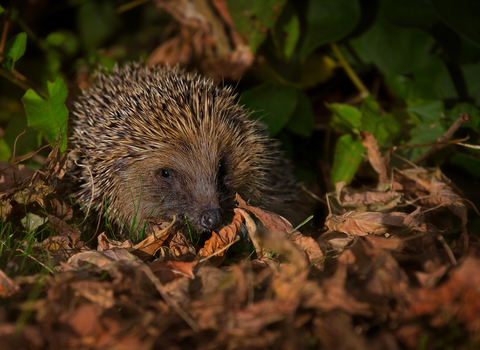Hedgehogs in the UK
Hedgehogs are one of the UK's favourite mammals. The sight of one snuffling through a garden on a summer's evening is a magical experience. But sadly, our hedgehogs are struggling. In 2022, a report on Britain's hedgehogs revealed they have declined by between 30-75% since 2000. Other evidence indicates that their numbers have been falling for much longer than this.
Hedgehog drinking from a water bowl (https://vimeo.com/911514506)
Hedgehog drinking © Stuart Edmunds
All about hedgehogs
European hedgehogs are small mammals found across the UK. They're unmistakeable thanks to their protective coat of spines, which are actually modified hairs known as quills. Just as with hair, they shed their quills over time and grow new ones to replace them. When a hedgehog is threatened, it curls into a tight, spiny ball until the threat goes away. Hedgehogs are nocturnal, venturing out at night to feed. They are one of the few mammals in the UK that truly hibernate through the winter.
Why do hedgehogs need protecting?
The decline in our hedgehog population has led to them being classed as vulnerable to extinction in Britain. The reasons for their decline are complex, with different issues between rural and urban areas. One problem is a lack of food. Hedgehogs enjoy a varied diet, but mainly feed on invertebrates like worms and beetles. The way much of the UK's land is managed has led to many of these invertebrates becoming rarer, leaving less food for hedgehogs.
Just as importantly, hedgehogs are also finding it harder to move around and find suitable places to feed, nest and hibernate. Roads, fences and large areas of open land can all discourage hedgehogs from moving across the landscape.
How can I help hedgehogs?
The best way to help hedgehogs at home is to make your garden as wild as possible, or at least include some wild patches. Bushes, log piles, ponds and longer lawns with plenty of wildflowers will provide a home for invertebrates, creating a buffet for hungry hedgehogs. A really wild patch will give hedgehogs natural nesting and hibernating spots, but you could lend an extra hand with a bespoke hedgehog home.
Finally, you need to make sure hedgehogs can reach your garden to enjoy all of this! If it's possible, swap out a boundary fence for a native hedge - if not, add a hedgehog hole to your fence so they can pass right through it. Could you talk to your neighbours about doing the same and creating a hedgehog highway on your street?
How will you help hedgehogs? Add it to our map!
Layers
How are the Wildlife Trusts helping?
We are working hard to create a wilder future, with plenty of invertebrates for hedgehogs to eat. By creating more spaces for nature and connecting them together, we will help hedgehogs and many other species make a comeback. Wildlife Trusts across the UK are also working on projects to help hedgehogs in their area, including:
The Wildlife Trusts for Lancashire, Manchester & North Merseyside
Help a Hog
The Wildlife Trust for Lancashire, Manchester & North Merseyside offers tips for helping hedgehogs with their Help a Hog guide. Every autumn, they encourage participation in an annual hedgehog survey. All of the results go to the local record centres to help monitor hedgehog populations.
Cheshire Wildlife Trust
Rewilding Stockport
As part of their Rewilding Stockport project, Cheshire Wildlife Trust is offering free hedgehog-friendly concrete base panels and installation to residents in Stockport. As well as recording hedgehogs sightings to monitor populations, they also record the presence of hedgehog holes in fences. This helps to assess how easily hedgehogs can move through neighbourhoods.
Surrey Wildlife Trust
Hedgehog Hotspots
Surrey Wildlife Trust encourages and records sightings of hedgehogs in Surrey, creating a hedgehog map of the county. This helps to monitor the population.




